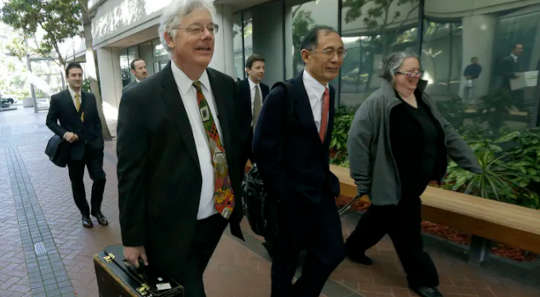 Attorneys for Apple heading to court during the so-called smartphone patent wars. AP Photo/Jeff Chiu
Attorneys for Apple heading to court during the so-called smartphone patent wars. AP Photo/Jeff Chiu
Over his career Thomas Edison garnered more U.S. patents than anyone in his time. Edison profited from his patents, but he was also exposed to the dark side of the patent system. He had to contend with lawsuits by other patentees who sought – and sometimes won – a piece of his success. While the patent system is designed to spur innovation like Edison’s, it also hampers it.
Easy copying and imitation discourage innovation, because why make the effort if someone else will profit from it? The patent system works by enabling inventors to block unauthorized use of patented technology.
Most technologies are developed by many inventors over many years, a process called “cumulative” innovation. Too often, however, early inventors get a patent on a small and perhaps insignificant piece of the technological puzzle, yet their patent covers the entire puzzle. Inventors who solve subsequent parts of the puzzle may need to pay royalties to the patentee, even if their contributions are larger.
As legal experts who focus on technology law and policy, we suggest that the problem boils down to two issues: too many patents and too little accurate information about them.
Too many patents
The U.S. is awash in patents. Over 350,000 U.S. patents were granted in 2019, four times the per capita rate in 1980. From the perspective of research managers at big firms, patents are cheap and easy to get. For example, in the early 2000s Bill Gates decided that Microsoft was patent-poor, and within a few years the company increased annual patent applications by 50%.
Patents are easy to get because the standards of patentability are low and because the burden is on the U.S. Patent and Trademark Office to prove an invention is not patentable. Patent examination is slow. It often takes three years or more. Despite increased staffing, the backlog of patent applications has continued to grow, and examiners spend on average only 20 hours reviewing each application. The patent examiner is required to read and understand the invention in an application, determine whether the invention meets the claims of the application, search existing technology to see if the invention already exists and write a response to the application.
Helter-skelter examination causes errors – many patents are too broad, or they cover obvious inventions. To draw attention to problems caused by the flood of low-quality patents, billionaire entrepreneur Mark Cuban endowed a chair at the Electronic Frontier Foundation dedicated to elimination of “stupid patents.”
Innovative firms that succeed in assembling many pieces of a technology puzzle into a finished product must consult with a patent lawyer to learn whether their new technology is covered by one or more patents owned by others. Ideally an innovator will get permission to use patented technology, usually for a fee, or redesign its technology to steer clear of relevant patents.
In practice this patent “clearance” process is difficult, costly and sometimes impossible. For technologies like smartphones, a patent attorney likely would need to review hundreds of patents, including many patents that are not granted until long after the new product is launched. Failure to license relevant patents creates a risk of litigation and the threat the new technology could be forced out of the marketplace.
As a result, smartphone patent litigation is far too common. Apple – a smartphone pioneer – has participated in scores of lawsuits around the globe as both a defendant and plaintiff. As a plaintiff, Apple sometimes uses its patents opportunistically to hinder innovation by its rivals.
For example, Apple sued Samsung using a patent that claimed the slide-to-unlock feature on a phone as Apple’s invention. Despite strong evidence that inventors before Apple had already accomplished the key steps to implement this feature, Apple convinced the courts that their version of this feature was patentable, and after seven years Samsung agreed to pay license fees to Apple to settle the case.
Economic research suggests that these litigation costs and license fees burden innovative firms to such a degree that on balance the patent system discourages innovation. In other words, innovative firms gain a benefit from their patents on their new technology, but that benefit is more than offset by the many patents owned by others that might be asserted against the new technology.
Too little information
When an inventor gets a patent, she is supposed to reveal the secret sauce behind the invention in the patent, a public document. This allows scientists and engineers to learn about the invention and use that information to improve the technology.
Or at least, that’s the theory. In practice, many inventors make shoddy disclosures. Experiments reported in patents are sometimes fictional and often rely on dubious methodology. For instance, patent law permits an inventor to disclose the fictional finding that a drug treats cancer as evidence that she deserves a patent on that drug.
Inventors applying for patents are allowed to include predicted experimental results. The intent is to allow for earlier disclosure and to help smaller companies secure funding. But when evidence in patents is wrong, other innovators can be misled. Further, if other innovators want to figure out if the patented drug really treats cancer – or any other disease – they need a license from the patentee.
Sometimes key pieces of evidence are missing entirely from patents. This happens when a patent covers aspects of a technology that the patentee didn’t actually invent. Imagine discovering that paper is a mediocre incandescent conductor in light bulbs and using that discovery to get a patent covering thousands of other conductors, including ones that, unbeknownst to you, work much better. Later innovators might want to figure out whether other substances are better conductors than paper, but they can’t even start experiments without a license.
This happened to Edison. He was sued for patent infringement after discovering a far better conductor than that discovered by the patentee – but because the patent was written broadly, it nevertheless covered Edison’s invention.
There is also too little information about the boundaries of patents. When an inventor gets a patent, she is also supposed to provide clear boundary information – what a patent application covers and what it doesn’t – to the public about her patent rights. The patent system fails to ensure this, however.
The boundary information in patent applications is hidden for 18 months until the application is published, and even longer if the boundaries change later during examination. Once the patent is granted, lawyers, judges and the public often have difficulty reaching agreement on the meaning of boundary language that may be intentionally vague or ambiguous.
How to fix the system
Inventors who come up with new chemicals, including pharmaceuticals, tend to benefit from the patent system. Unfortunately, the system appears to impose a net cost on most other technologies, especially in high-tech industries.
Opportunistic patent owners, often called patent trolls, surprise inventors with patent claims about inventions that are minor or distantly related to the technology that is the target of the suit. Economics research shows such trolling activity slows innovation.
[Over 100,000 readers rely on The Conversation’s newsletter to understand the world. Sign up today.]
The patent system can be improved to deliver a net gain to all inventors even without being drastically reworked. A good start would be to rigorously enforce existing standards about information disclosure. Courts should push inventors to clearly describe and explain their inventions.
The flood of patents on minor technical advances could be ended if patent fees were increased and if the nonobviousness standard, which screens out minor advances, was made stronger. Reducing the number of patents and increasing the amount of information about each patent would go a long way toward making the patent system work the way it was intended.![]()
About The Authors
Michael J. Meurer, Professor of Law, Boston University and Janet Freilich, Associate Professor of Law, Fordham University
This article is republished from The Conversation under a Creative Commons license. Read the original article.
Recommended books:
Capital in the Twenty-First Century
by Thomas Piketty. (Translated by Arthur Goldhammer)
 In Capital in the Twenty-First Century, Thomas Piketty analyzes a unique collection of data from twenty countries, ranging as far back as the eighteenth century, to uncover key economic and social patterns. But economic trends are not acts of God. Political action has curbed dangerous inequalities in the past, says Thomas Piketty, and may do so again. A work of extraordinary ambition, originality, and rigor, Capital in the Twenty-First Century reorients our understanding of economic history and confronts us with sobering lessons for today. His findings will transform debate and set the agenda for the next generation of thought about wealth and inequality.
In Capital in the Twenty-First Century, Thomas Piketty analyzes a unique collection of data from twenty countries, ranging as far back as the eighteenth century, to uncover key economic and social patterns. But economic trends are not acts of God. Political action has curbed dangerous inequalities in the past, says Thomas Piketty, and may do so again. A work of extraordinary ambition, originality, and rigor, Capital in the Twenty-First Century reorients our understanding of economic history and confronts us with sobering lessons for today. His findings will transform debate and set the agenda for the next generation of thought about wealth and inequality.
Click here for more info and/or to order this book on Amazon.
Nature's Fortune: How Business and Society Thrive by Investing in Nature
by Mark R. Tercek and Jonathan S. Adams.
 What is nature worth? The answer to this question—which traditionally has been framed in environmental terms—is revolutionizing the way we do business. In Nature’s Fortune, Mark Tercek, CEO of The Nature Conservancy and former investment banker, and science writer Jonathan Adams argue that nature is not only the foundation of human well-being, but also the smartest commercial investment any business or government can make. The forests, floodplains, and oyster reefs often seen simply as raw materials or as obstacles to be cleared in the name of progress are, in fact as important to our future prosperity as technology or law or business innovation. Nature’s Fortune offers an essential guide to the world’s economic—and environmental—well-being.
What is nature worth? The answer to this question—which traditionally has been framed in environmental terms—is revolutionizing the way we do business. In Nature’s Fortune, Mark Tercek, CEO of The Nature Conservancy and former investment banker, and science writer Jonathan Adams argue that nature is not only the foundation of human well-being, but also the smartest commercial investment any business or government can make. The forests, floodplains, and oyster reefs often seen simply as raw materials or as obstacles to be cleared in the name of progress are, in fact as important to our future prosperity as technology or law or business innovation. Nature’s Fortune offers an essential guide to the world’s economic—and environmental—well-being.
Click here for more info and/or to order this book on Amazon.
Beyond Outrage: What has gone wrong with our economy and our democracy, and how to fix it -- by Robert B. Reich
 In this timely book, Robert B. Reich argues that nothing good happens in Washington unless citizens are energized and organized to make sure Washington acts in the public good. The first step is to see the big picture. Beyond Outrage connects the dots, showing why the increasing share of income and wealth going to the top has hobbled jobs and growth for everyone else, undermining our democracy; caused Americans to become increasingly cynical about public life; and turned many Americans against one another. He also explains why the proposals of the “regressive right” are dead wrong and provides a clear roadmap of what must be done instead. Here’s a plan for action for everyone who cares about the future of America.
In this timely book, Robert B. Reich argues that nothing good happens in Washington unless citizens are energized and organized to make sure Washington acts in the public good. The first step is to see the big picture. Beyond Outrage connects the dots, showing why the increasing share of income and wealth going to the top has hobbled jobs and growth for everyone else, undermining our democracy; caused Americans to become increasingly cynical about public life; and turned many Americans against one another. He also explains why the proposals of the “regressive right” are dead wrong and provides a clear roadmap of what must be done instead. Here’s a plan for action for everyone who cares about the future of America.
Click here for more info or to order this book on Amazon.
This Changes Everything: Occupy Wall Street and the 99% Movement
by Sarah van Gelder and staff of YES! Magazine.
 This Changes Everything shows how the Occupy movement is shifting the way people view themselves and the world, the kind of society they believe is possible, and their own involvement in creating a society that works for the 99% rather than just the 1%. Attempts to pigeonhole this decentralized, fast-evolving movement have led to confusion and misperception. In this volume, the editors of YES! Magazine bring together voices from inside and outside the protests to convey the issues, possibilities, and personalities associated with the Occupy Wall Street movement. This book features contributions from Naomi Klein, David Korten, Rebecca Solnit, Ralph Nader, and others, as well as Occupy activists who were there from the beginning.
This Changes Everything shows how the Occupy movement is shifting the way people view themselves and the world, the kind of society they believe is possible, and their own involvement in creating a society that works for the 99% rather than just the 1%. Attempts to pigeonhole this decentralized, fast-evolving movement have led to confusion and misperception. In this volume, the editors of YES! Magazine bring together voices from inside and outside the protests to convey the issues, possibilities, and personalities associated with the Occupy Wall Street movement. This book features contributions from Naomi Klein, David Korten, Rebecca Solnit, Ralph Nader, and others, as well as Occupy activists who were there from the beginning.
Click here for more info and/or to order this book on Amazon.
























